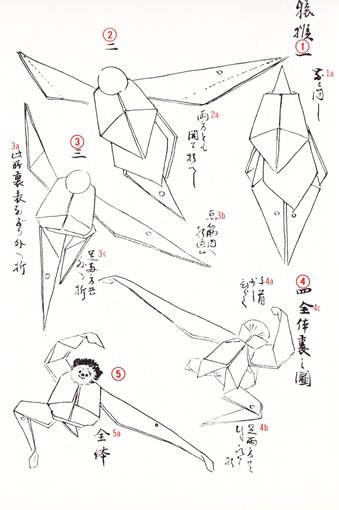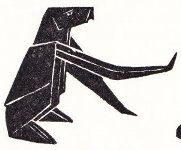| The Public Paperfolding History Project
Last updated 5/12/2023 x |
|||||||
| Folded Paper Monkeys and Apes | |||||||
| This
page is being used to collect information about the
history of folded paper monkeys and apes. Please contact
me if you know any of this information is incorrect or if
you have any other information that should be added.
Thank you. ********** 1845 There are two designs for Monkeys in the Kan No Mado, which is usually dated to 1845. Dancing Monkey (from the slit hexagon base).
*** Long Armed Monkey (from the irregular slit octagon base)
********** 1922 A design for a monkey developed from a frog base appears in a column by Ramon Gomez de la Serna titled La vida - La evolucion de la pajarita', which was published in the newspaper 'El Liberal' on 5th April 1922. The same drawing appears in Ramon Gomez de la Serna's book 'Variaciones', which was also also published in 1922.
Don Miguel claims to have invented a mono / monkey design in the Prologo-epilogo to the revised 1934 edition of 'Apuntes para un tratado de cocotología'. However, on the basis of information obtained by his father, Felix Gimeno, from some of Don Miguel's children, Juan Gimeno believes that this design was invented by Don Miguel's son, Paul, rather than Don Miguel himself. ********** 1944 'Origami Shuko' by Isao Honda, which was published in 1944, contains two cut designs for monkeys.. Koshin Monkey (Cut)
********** Monkey
********** A design for 'El Mono' (the monkey) developed from a bird base appears in the second edition of 'Papiro-Zoo: Manual Practico de Papirologia o Cocotologia' by Giordano Lareo, which was published by Libraria 'El Ateneo' Editorial in Buenos Aires in 1944. This design only has one back leg.
********** 1956 There is a design for a 'Dog-Faced Monkey' in 'Paper Magic' by Robert Harbin, which was published by Oldbourne in London in 1956.
********** 1960 A compound design for a 'A Monkey' appears in 'All About Origami' by Isao Honda, which was published by Toto Bunka Company, Limited in Tokyo in 1960.
*** The same book contains compound designs for 'Three (Wise) Monkeys'. Each monkey is made from two 60/120 degree rhombii.
********** 1965 A reconstruction of the Kan no mado monkey, folded from a partially slit irregular octagon, appears in 'The World of Origami' by Isao Honda, which was published by Japan Publications Trading Company in the USA in 1965 as 'Gibbon'.
********** |
|||||||











